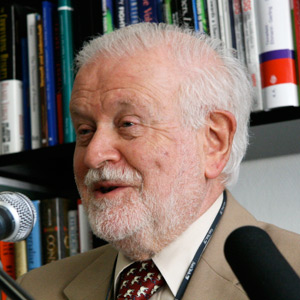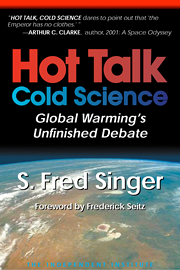The primary mission of the Science and Environmental Policy Project has been to study and analyze how science is used—or misused—in the setting of federal environmental policies, and then expose the most egregious examples of environmental malfeasance. There are so many: Superfund, asbestos, Alar, acid rain, to mention just a few—all of them costing mega-billions and backed by insubstantial science.
When we decided to list the greatest environmental myths of 1995, our board of experts finally settled on the following five topics that demonstrate distortion or misuse of science in shaping policies. We present them here to educate policymakers and the public in the hope that the publicity will lead to more cost-effective policies and a healthier environment.
(1) Global warming and the Climate Treaty: During 1995, scare stories about a future catastrophic greenhouse warming gained much momentum, while at the same time the evidence for such warming became weaker and weaker. At the first “Conference of the Parties” to the Global Climate Treaty in Berlin in April, the science was ignored while the assembled “statesmen” went ahead to establish a permanent secretariat and plan further mega-meetings. In September, at the initiative of Al Gore, a Washington conference promoted a new fear tied to global warming: a spread of tropical diseases putting 3 billion people at risk.
Finally, in November (in Madrid) and December (in Rome), the U.N.-sponsored Intergovernmental Panel on Climate Change (IPCC), the scientific arm of the Treaty, managed to approve two pre-drafted summary reports. These can charitably be described as being “economical with the truth.” By selectively presenting some facts, but withholding crucial information (such as that the data show a warming rate of zero!), they convey the impression of impending doom and provide a spur for hasty and ill-advised action to cut the use of energy fuels.
With the Treaty bureaucracy charging ahead without regard for the scientific evidence, we’d better withdraw from the Treaty before a U.N. agency forces us into economic ruin.
(2) Stratospheric ozone and skin cancer: Dec. 31, 1995, marked the date when the production of CFCs (“freons”) and other useful chemicals was banned in the mistaken belief this policy would avert an epidemic of skin cancer. Scientific evidence does not support this hasty action, which was largely based on a 1992 press conference that intimated an imminent “Arctic ozone hole” that never was. There is no data to indicate that ultraviolet radiation reaching the Earth’s surface is increasing by even a few percent—as might be expected if the ozone layer were thinning. In the meantime, it is generally recognized that W increases naturally when one moves toward the equator; W levels in Florida are 200 percent to 300 percent higher than in New England! Furthermore, laboratory measurements show that deadly melanoma skin cancers would not be affected by the atmospheric ozone level.
Notwithstanding all the evidence, in testimony to Congress in August and again in September, the Environmental Protection Agency (EPA) claimed the CFC ban will produce benefits of as much as $32 trillion (!), with benefit-cost ratios of 700–1,000! This is sheer fantasy, as well as bad science and economics. EPA should add to this the tens of millions of motorists who won’t be able to run their car air conditioners except by shelling out $200 to $800—or risking jail through buying smuggled CFC on the black market.
(3) The secondhand smoke scare: In November 1995, the Congressional Research Service, the research arm of the U.S. Congress, issued a scholarly report that reviewed published studies bearing on possible lung cancer effects on nonsmokers from environmental tobacco smoke (ETS), often referred to as “secondhand” smoke. The CRS found no support for the 1992 action of the EPA that declared ETS a “Class A carcinogen” in the workplace—which in turn would permit the Occupational Safety and Health Administration (OSHA) to regulate smoking in business establishments.
The problem is that the risk for lung cancer is not statistically significant under the usual definition of that term. To arrive at its conclusion, the EPA changed the definition by accepting a lower standard of “significance.” This cavalier treatment of data has been widely criticized by independent academic scientists; EPA was accused of “manipulation of data,” violation of “time-honored statistical principles,” and worse.
This does not mean that ETS does not or cannot cause lung cancer in nonsmokers; it only means that the EPA distorted science to establish a correlation and suggest a causation that cannot be proven with the data at hand.
(4) The phony radon scare: Before World War II, radioactivity in small doses was considered healthful; rich people went to spas to drink the slightly radioactive water and exposed themselves to radon in old uranium mines. The explosion of two atomic bombs changed all that; it has produced an exaggerated fear of radioactivity, no matter how small. It was only in 1995, however, that good evidence was published showing the existence of a “threshold,” below which health effects seem to disappear.
Of course, this result could have been predicted. After all, we are constantly exposed to nuclear radiation from natural sources. The ground we walk on is slightly radioactive. Cosmic rays are everywhere and increase in intensity with altitude. Long-term exposure in jet aircraft can quickly accumulate a substantial radiation dose. Even our bodies contain natural radioactivity.
Thus it is somewhat ironic that the EPA is stirring up more fears just as we learn that naturally occurring radon is a very minor risk for lung cancer. Despite the evidence, however, EPA refuses to accept the “threshold hypothesis” and insists on calculating cancer rates that are quite unrealistic. By enlisting private “radon partners,” they have tried to scare households into costly mitigation programs against radon. At $1,000 or more per home, such programs could soon reach the mega-billion range. Still, EPA seems to be doing all it can to defend its announced position that radon is the “No. 1 environmental health hazard.”
(5) The wasteful pursuit of zero risk: Perhaps the costliest of all regulations is embodied in law in the 1958 Delaney clause, which mandates essentially zero risk. It bans the addition to food of any substance that has been found to cause cancer when fed in huge doses to rats. Its spirit—”one molecule can kill”—pervades the Superfund law and other laws that involve the regulation of chemicals thought to be cancer-producing: PCB, dioxin, ETS, Alar, etc. In many laws the risk level is set at 1-in-a-million. Even though this is better than a zero-risk level, it is still arbitrary and unrealistic—since the normal cancer risk is 25 percent—i.e., 250,000-in-a-million. The EPA doesn’t want it to rise to 250,001-in-a-million—no matter how high the cost.
During 1995, Congress made its first attempt—and almost succeeded—to rationalize federal policies for a better environment by introducing legislation in the House and Senate to balance the cost of regulation against the benefits. In that way, our limited resources could be brought to bear against real risks to human health and not squandered on “phantom risks.” Ideally, it would allow consideration of comparative risk, instead of spending funds on the “scare of the year”—whether asbestos, radon, lead, pesticides, etc. One should consider that environmental regulation is now costing the nation more than $150 billion per year, or more than $1,500 per household. Once spent, that money cannot then be used to buy food, medicine, or other essentials.
Hopefully, the 104th Congress will complete the job in 1996 and repeal the Delaney clause and thereby the whole “zero-risk” mentality. The nation will be better off for it.









